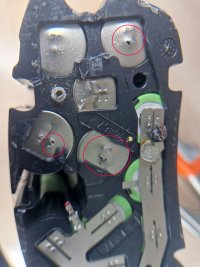ok, here is another n00b 
after doing some investigation i decided that i want to build a powerwall.
already i have 3 suppliers where i can pickup e-bike batteries for free now al i have to do is take them part and test them.
now al i have to do is take them part and test them.
the basics:
my first desision was that i want to go with a system where i can swap cells easy, with comon, easy to get parts. so i go with a 18650 pcb system with cell holders.
I have not fully decided yet, wich pcb i am going to use.
1. https://www.electronics-lab.com/diy-18650-powerwall-onboard-bms/
this is "my winner" so far, i like the fact that it has a bms system per cell. there are also a few thinks i don't like, mainly the lack of documentation or reviews on this board. also, the cells can only be populated on one side of the pcb. the pcb manufacturer can also take care of soldering all smd components.
2.
nice design, not much info about bms connections, or use with the jehu bms pcb. also, populaties only on one side.
3. https://jag35.com/collections/jehus...gh-power-18650-battery-module-diy-pcb-kit-10x
this can hold 2x7 cell per pcb. lot of documentaton. don't like the need of an external pcb.
still need to make the decision and order the pcb's and other components, i am quirious about your toughts.
i will store everything in a 22U 19 inch rack, mounting everything on shelfs, so that problem is solved.
the next problem is the inverter / charger. maybe this is also a good reason to explain why i want to build a wall.
in The Netherlands where i live there is a high hourly fluctuation of energy prices (spot market), see: https://www.easyenergy.com/nl/energietarieven
i want to buy power at the lowest rate from the grid, and sell back at the highest rate.
our connection to the grid is 3x35A (can upgrade to 3x80A, maybe later) 230V, so approx 23KW/h. if i want to store 6 hours of energy, i need a powerwall of at least 150KW/h. i see fluctuation between lo and high of 30 cents.
so, i need a (or multiple) inverter, that can handle this. i need to be able to set to charge /discharge or idle, preferable controlled via HomeAssistant, most ideal is fully automating charge and discharge moments (see https://community.home-assistant.io...rgy-prices-to-activate-electric-boiler/154445 for a positie example).
i see all kind of different projects, most of them has separate chargers and inverters. is there anybody that can give some advice on this? the pack will grow as i proceed, i hope that i can reach somewhere in the region of storing 300KW when finished, and be able to charge and discharge the whole pack in only 6 hours.
Thanks!
Ivan
after doing some investigation i decided that i want to build a powerwall.
already i have 3 suppliers where i can pickup e-bike batteries for free
the basics:
my first desision was that i want to go with a system where i can swap cells easy, with comon, easy to get parts. so i go with a 18650 pcb system with cell holders.
I have not fully decided yet, wich pcb i am going to use.
1. https://www.electronics-lab.com/diy-18650-powerwall-onboard-bms/
this is "my winner" so far, i like the fact that it has a bms system per cell. there are also a few thinks i don't like, mainly the lack of documentation or reviews on this board. also, the cells can only be populated on one side of the pcb. the pcb manufacturer can also take care of soldering all smd components.
2.
7S battery holder - EasyEDA open source hardware lab
In EasyEDA open source hardware lab, open source square pools all kinds of electrical design engineerings together to realize resource sharing easily.
oshwlab.com
nice design, not much info about bms connections, or use with the jehu bms pcb. also, populaties only on one side.
3. https://jag35.com/collections/jehus...gh-power-18650-battery-module-diy-pcb-kit-10x
this can hold 2x7 cell per pcb. lot of documentaton. don't like the need of an external pcb.
still need to make the decision and order the pcb's and other components, i am quirious about your toughts.
i will store everything in a 22U 19 inch rack, mounting everything on shelfs, so that problem is solved.
the next problem is the inverter / charger. maybe this is also a good reason to explain why i want to build a wall.
in The Netherlands where i live there is a high hourly fluctuation of energy prices (spot market), see: https://www.easyenergy.com/nl/energietarieven
i want to buy power at the lowest rate from the grid, and sell back at the highest rate.
our connection to the grid is 3x35A (can upgrade to 3x80A, maybe later) 230V, so approx 23KW/h. if i want to store 6 hours of energy, i need a powerwall of at least 150KW/h. i see fluctuation between lo and high of 30 cents.
so, i need a (or multiple) inverter, that can handle this. i need to be able to set to charge /discharge or idle, preferable controlled via HomeAssistant, most ideal is fully automating charge and discharge moments (see https://community.home-assistant.io...rgy-prices-to-activate-electric-boiler/154445 for a positie example).
i see all kind of different projects, most of them has separate chargers and inverters. is there anybody that can give some advice on this? the pack will grow as i proceed, i hope that i can reach somewhere in the region of storing 300KW when finished, and be able to charge and discharge the whole pack in only 6 hours.
Thanks!
Ivan





